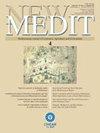一项实地调查表明,突尼斯南部Kebili地区的绿洲特征发生了变化
IF 1.2
4区 经济学
Q3 AGRICULTURAL ECONOMICS & POLICY
引用次数: 1
摘要
自成立以来,“传统”绿洲被认为是三层的,而现代绿洲从一开始就只有一层“Deglet Nour”椰枣品种。然而,这些定义可能不再适用于Kebilian绿洲。因此,对Kebilian绿洲(“传统”n=26和“现代”n=26)的52个地块进行了随机抽样调查,以调查现状。通过数据透视表方法和Chi-2独立性测试,以及通过递增层次分类分析完成的多成分分析,对收集的数据进行分析,以表征和分类每种绿洲类型。我们的研究结果表明,“现代”绿洲的作物多样性比预期的要大,可以分为两个或三个绿洲。相比之下,在“传统”绿洲中,高作物多样性和三个垂直层的出现频率低于预期。我们的调查发现,绿洲的可用水量和灌溉频率是柯比连绿洲布局和类型变化的关键因素。农业生物多样性的丧失可能危及“传统”绿洲绿洲系统的可持续性。本文章由计算机程序翻译,如有差异,请以英文原文为准。
A field survey suggests changes in oasis characteristics in the Kebili region of southern Tunisia
Since their establishment, “traditional” oases have been known to be three-layered, while modern oaseshave been organized from their outset with one layer only of ‘Deglet Nour’ date palm cultivars. However, these definitions may no longer apply for Kebilian oases. A survey was therefore carried out on a random sample of 52 plots in Kebilian oases (“traditional” n=26 and “modern” n=26) to investigate the current situation. The data collected were analysed by the Pivot Tables method and a Chi-2 test of independence, and by a Multiple Component Analysis completed by an Ascending Hierarchical Classification analysis to characterise and classify each oasis type. Our results showed that “modern” oases have greater crop diversity than expected and can be organized in two or three-layer oases. In contrast, high crop diversity and the three vertical layers were found to be less frequent than expected in “traditional” oases. Our investigation found water availability in the oases, and irrigation frequency, to be the key factors of Kebilian oasis layout and typology changes. Agro-biodiversity losses could jeopardize the sustainability of the oasis system in “traditional” oases.
求助全文
通过发布文献求助,成功后即可免费获取论文全文。
去求助
来源期刊

New Medit
AGRICULTURE, MULTIDISCIPLINARY-
CiteScore
2.00
自引率
30.00%
发文量
31
审稿时长
>12 weeks
期刊介绍:
New Medit is an applied economics journal, with a multidisciplinary approach, aimed at providing insights into the economic and the social transformations of agro-food sector, rural societies as well as local development and bioeconomy in the Mediterranean Basin.
Manuscripts submitted to NEW MEDIT generally should deal with wide-ranging topics that can be extended to other countries where organisational, production and market conditions and the related development policies may emerge at the corporate or regional level.
 求助内容:
求助内容: 应助结果提醒方式:
应助结果提醒方式:


